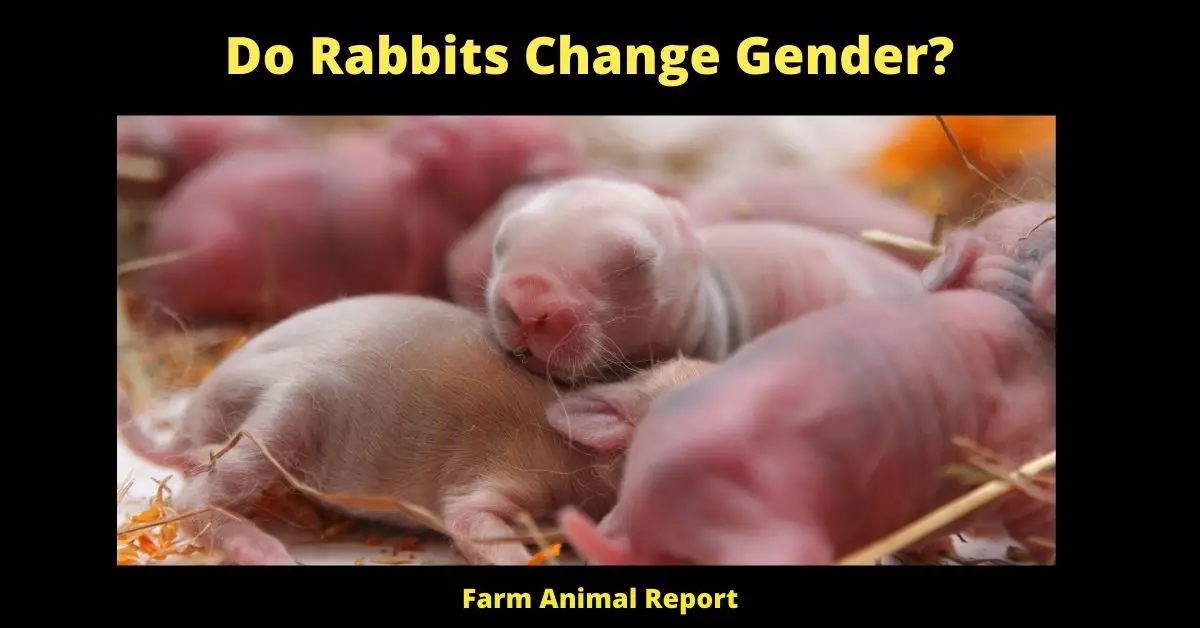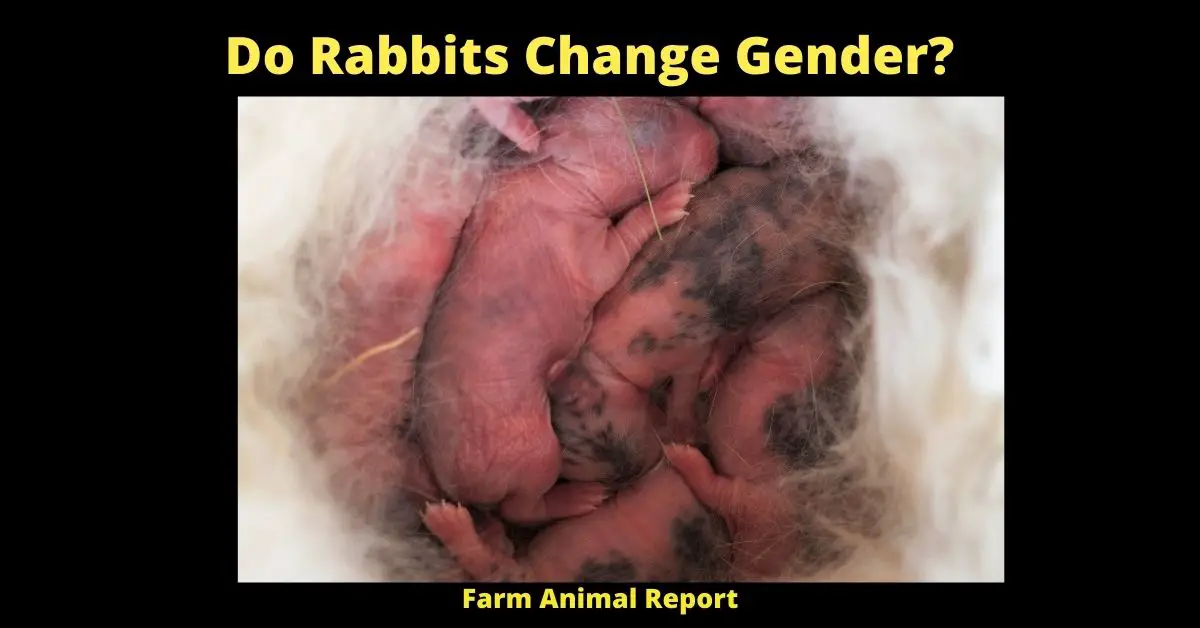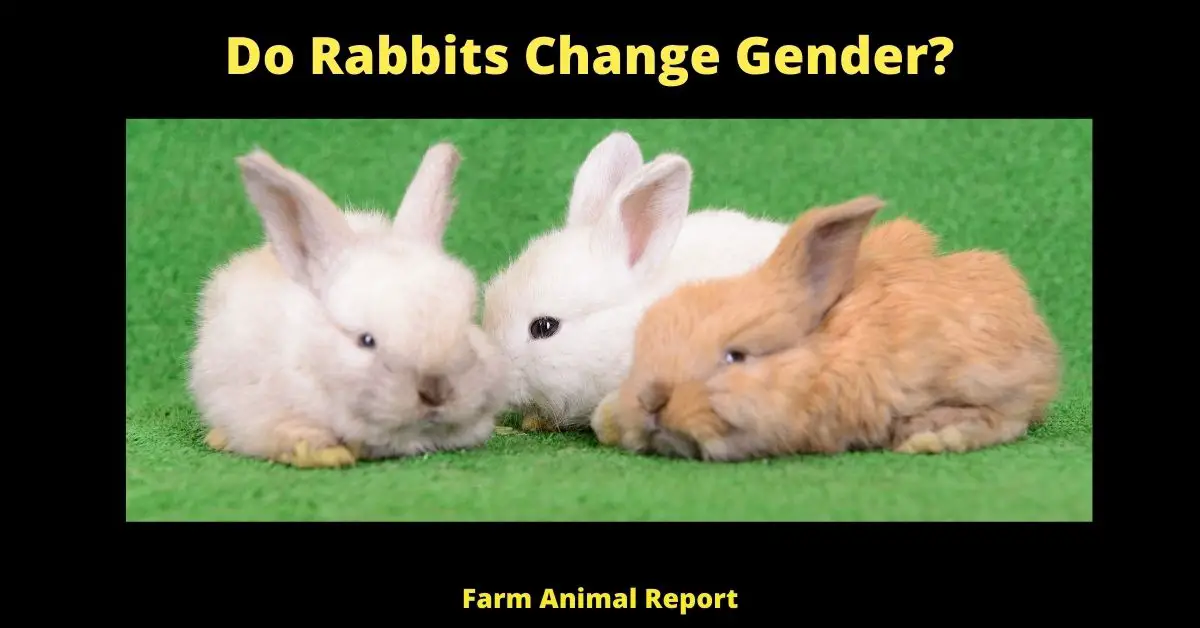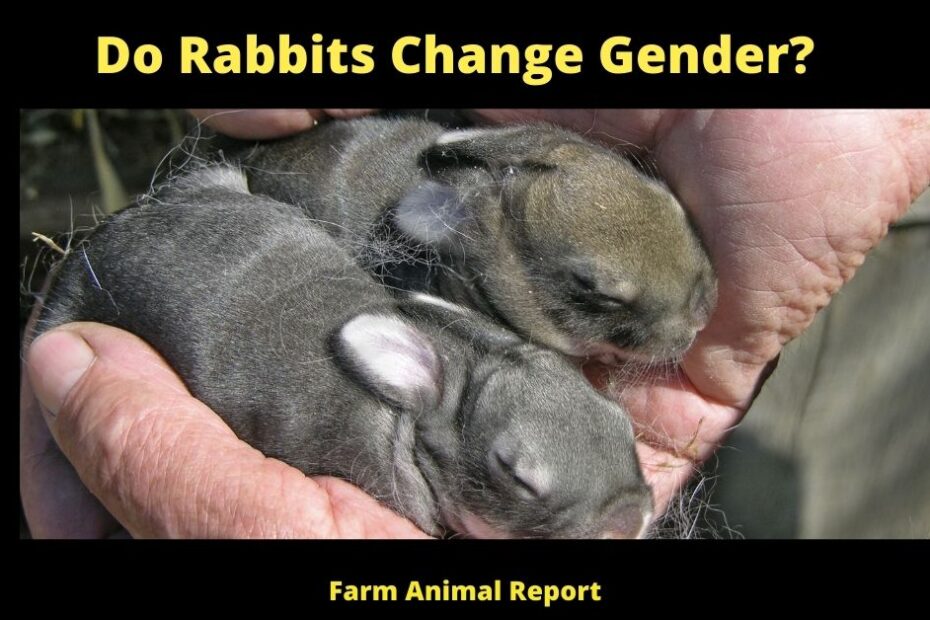Rabbits are known for being prolific breeders, so it’s no surprise that there are many questions about rabbit reproduction. One common question is whether or not rabbits change gender as they grow up. The answer is no, rabbits do not change gender as they grow up. Their sex organs develop during gestation, and by the time they are born, their gender is set.
Do Rabbits Change Gender?
Do rabbits change gender? No, they do not. Rabbits are born as either male or female and they remain that way for their entire lives. There is no such thing as a transgender rabbit. This is a common misconception, likely because of the way rabbits reproduce.
Male and female rabbits come together to mate and the female rabbit becomes pregnant. She then gives birth to a litter of baby rabbits, which are all either male or female. So while it may appear that rabbits are changing gender, they are actually just reproducing.

What is Dichogamy in Animals?
Dichogamy is a term used to describe the reproductive strategy employed by some animals, in which male and female gametes are produced at different times.
This ensures that self-fertilization does not occur and that individuals are able to mate with a partner of the opposite sex.
Dichogamy can take one of two forms: temporal dichogamy, in which male and female gametes are produced at different times within the same individual; or spatial dichogamy, in which male and female gametes are produced by different individuals. Do Rabbits Change Gender?
Check Out Amazon for Resources about Breeding Rabbits
This strategy ensures that offspring are genetically diverse and that members of the population have the opportunity to mate with a wide range of partners. As a result, dichogamy is thought to promote the health and fitness of populations.
What Is Sequential Hermaphroditism?
Sequential hermaphroditism is a type of hermaphroditism in which an organism changes its sex during its lifetime. Most sequentially hermaphroditic species have two distinct sexes: male and female.
However, a few species are capable of switching between genders multiple times. Sequential hermaphroditism is found in a wide variety of animals, from fish to insects to reptiles.
In most cases, the change from one sex to another is triggered by changes in the environment, such as the presence of other members of the same species or a change in temperature. In some species, however, the switch between genders is completely random.
Regardless of how it occurs, sequential hermaphroditism provides organisms with a reproductive advantage by allowing them to produce offspring no matter what the gender balance of their environment happens to be.
Sequential hermaphroditism is a type of reproductive system found in certain animals, in which the individual changes sex at some point in their life.
Many sequentially hermaphroditic species are protogynous, meaning they begin life as female and later change to male. Others are protandrous, meaning they start out as male and transition to female. Sequential hermaphroditism can occur for a variety of reasons, including environmental factors such as water temperature or the availability of mates.

Some species are capable of self-fertilization, while others rely on cross-fertilization in order to reproduce. Many animals that exhibit sequential hermaphroditism are highly territorial, and the changing of sexes allows them to maintain their territory throughout their lifetime.
When is The gender of a Rabbit Determined?
The gender of a rabbit is determined by the breeder when the rabbits are born. Male rabbits are typically larger than female rabbits, and they have more body mass.
They also have longer tails and broader faces. Female rabbits tend to be smaller than male rabbits and have shorter tails. They also have narrower faces and less body mass.
The easiest way to determine the gender of a rabbit is to look at the size and shape of the rabbit’s genitals. Male rabbits have large testicles, while female rabbits have smaller vulvas. If you are still unsure of the rabbit’s gender, you can ask a vet or animal specialist to help you determine the rabbit’s gender.
The gender of a rabbit is usually determined soon after birth. However, in some cases, it may not be possible to tell until the rabbit is fully grown. There are several factors that can influence the gender of a rabbit, including genetics and hormones. In most cases, the gender of a rabbit is determined by its chromosomes.
Male rabbits typically have two X chromosomes, while female rabbits have one X and one Y chromosome. However, there are also rabbits with XXY or XYY chromosomal makeup. These rabbits are often sterile and may exhibit physical characteristics of both genders. In rare cases, the gender of a rabbit may be influenced by hormones.
If a pregnant rabbit is exposed to high levels of testosterone, for example, her offspring may be born with male genitalia even if they have two X chromosomes. Ultimately, the best way to determine the gender of a rabbit is to wait until it is fully grown and then consult with a veterinarian or experienced breeder.
What is Gender in Rabbits and how is it Determined?
There are two main genders of rabbits, male and female. Most people can easily identify a rabbit’s sex by looking at the animal’s external genitalia, which is typically located in an unambiguous spot on the body. In males, this is the scrotum, while females have a more obscure area known as the vulva.
The gender of a rabbit can also be determined via genetic testing or behavioral observations. Regardless of how it is determined, gender plays an important role when it comes to rabbit care. For instance, choices in housing, nutrition, and health will depend on whether the rabbit is male or female.
Furthermore, certain aspects of biology may also differ based on gender. For example, females tend to have slightly shorter life spans than males due to their ability to reproduce multiple times each year. Overall, understanding what makes rabbits different by gender is an important part of taking good care of these adorable creatures.
In Rabbit Litters what is the Male/Female Ratio?
The average litter size for rabbits is four, although this can vary somewhat depending on the breed. The sex ratio of rabbits in a litter is usually close to 50/50, although there is some variation depending on the specific rabbits involved.
Some studies have shown that male rabbits are slightly more likely to be born in litters of odd-numbered sizes, while female rabbits are slightly more likely to be born in litters of even-numbered sizes. However, these differences are relatively small and are not thought to be biologically significant. In general, the sex ratio of rabbit litters is close to 50/50.
What effect do Neutering and Spaying have on Your Rabbit?
Spaying and neutering of rabbits is a topic that is commonly misunderstood. Some believe that neutering or spaying your rabbit will lead to health complications, while others simply worry about the overall wellbeing of their pet. In reality, however, spaying and neutering can have a number of positive effects on your rabbit’s health.
For one thing, these procedures will reduce or eliminate your rabbit’s risk of developing serious medical conditions like cancer and mammary tumors, both of which are common in unaltered female rabbits.
Additionally, sterilizing your pet will also decrease any behavioral issues that might arise due to unwanted sexual activity, such as mounting other pets or “marking” with urine. Ultimately, if you want to give your rabbit the best possible care, it is important to consider having it spayed or neutered by a qualified vet.
How do you know if a Rabbit is Male or Female?
The sex of a rabbit can be determined by looking at several key characteristics. For one, male rabbits tend to have longer bodies and larger heads than females. In addition, male rabbits have visible testicles, which can easily be seen on either side of the body when they are fully-grown.
Another way to distinguish between males and females is by checking the size of their ears. Male rabbits generally have larger, broader ears than females, which tend to be flatter and more lined.
Other indicators include differences in behavior and temperament as well as differences in sight and smell preferences. Overall, these factors can help you to determine whether a rabbit is male or female with relative ease.
What are Animals that can Change Gender Called?
Animals that are capable of changing their gender during their lifetimes are known as gender-bender animals. This ability to switch between male and female roles is found in many species, including some insects, fish, amphibians, birds, and mammals
One of the most well-known examples of a gender-bender animal is the clownfish. These small fish are typically born as males but can become “comfortably” female if they mate with a larger female in the same group.
Other examples of gender-bending animals include certain seagulls, scuds (tiny crustaceans), painted dragon lizards, and blacktip dolphins. Given the wide spectrum of animals that can change genders, it seems clear that this fascinating trait is an important evolutionary tool designed to help certain species adapt to varying environmental conditions over time. After all, with their shifting gender roles, these animals are truly ready for anything
Are Rabbits Hermaphrodite?
In Extremely rare genetic anomalies a rabbit may be hermaphrodite. This means they have both male and female genitalia. Hermaphrodite animals are very rare and it’s not something that commonly occurs in rabbits.
Many people believe that rabbits are hermaphrodites, meaning that they are able to possess both male and female sex characteristics. However, this is not actually true. While rabbits do possess both sex organs, they only use these organs in the mating process when necessary. Most of the time, rabbits have distinct male or female characteristics that are determined by genetics and factors such as hormone levels.
Additionally, it is important to note that a rabbit’s ability to self-fertilize is very limited; generally speaking, the majority of breeding interactions between rabbits involve at least one member of each gender. So while it may be tempting to assume that rabbits are hermaphrodites based on their outward appearance, we can safely say that this is not the case
What is Spontaneous Gender Change?
Spontaneous gender change is a rare phenomenon that has been documented in a number of different animal species. One of the best-known examples is the clownfish, which lives in harem-like groups consisting of one male and several females.
If the male clownfish is removed from the group, one of the females will undergo a dramatic transformation, developing male characteristics such as larger size and reproductive organs. This allows the transformed individual to take over the role of the male and mate with the remaining females.
While spontaneous gender change is most commonly seen in fish, it has also been reported in reptiles, amphibians, and even certain mammals. Despite being extremely rare, this fascinating phenomenon provides insight into the amazing diversity of animal life on our planet.

What are the 9 lifecycle phases of a Rabbit?
The nine phases of a rabbit’s life are:
- Birth
- Nursing
- Weaning
- Juvenile
- Subadult
- Adult
- Pregnancy
- Lactation
- Death.
These stages can be further broken down into specific age ranges, but the general timeline remains the same. For example, a rabbit will typically be born between 28 and 32 days after conception, and wean between 42 and 49 days old.
After reaching adulthood at around six months old, a rabbit can begin reproducing and will continue to do so until its death. It is important to note that rabbits have a relatively short lifespan; on average, they live for about three to five years in the wild, and slightly longer in captivity. However, some individual rabbits have been known to live for ten years or more.
Can Frogs change Gender?
While frogs come in a variety of colors, sizes, and shapes, one thing that all frogs have in common is that they are amphibians. This means that they can live both in water and on land. Frogs start their lives as tadpoles in the water.
As they grow, they undergo a process known as metamorphosis, during which they develop lungs and begin to live on land. Some species of frogs are able to change their gender during this process. For example, the African frog Hemisus marmoratus starts out as male but can turn into a female if there are not enough males present.
Similarly, the Sonoran Desert Toad will turn from female to male if there are not enough females around. While most frogs undergo metamorphosis from tadpole to adult without changing gender, some species have the ability to change genders depending on their environment.
Can Hamsters Change Gender?
Hamsters are not able to change their gender. Gender is determined by the presence of sex chromosomes, and these cannot be changed.
Hamsters have two sex chromosomes, XX for females and XY for males. In order for a hamster to change its gender, it would need to have a different combination of sex chromosomes. However, this is not possible, as sex chromosomes are inherited from the parents and cannot be altered.
As a result, hamsters will always remain the same gender throughout their lifetime.
Can Chickens Change Gender?
No, chickens cannot change gender. Chickens are born either male or female, and their sex is determined by their chromosomes. However, there are some rare cases in which a chicken’s physical appearance does not match its chromosomal sex.
These birds are called intersex chickens, and they typically have both male and female reproductive organs. While intersex chickens cannot change their gender, they can mate with other chickens and produce offspring.
Therefore, while Chickens cannot change gender, they can contribute to the genetic diversity of the flock.
Can Guinea Pigs change Gender?
Gender refers to the biological characteristics of males and females. For example, male guinea pigs have testes, while female guinea pigs have ovaries. However, it is possible for a guinea pig to change its gender.
This can happen if the guinea pig has a condition called intersex, which means that it has both male and female reproductive organs. Intersex guinea pigs are relatively rare, and they usually need to be surgically changed to one gender or the other.
However, some intersex guinea pigs are able to live healthy lives without surgery. In conclusion, while most guinea pigs are born either male or female, there is a small percentage of intersex guinea pigs that can change their gender.
Can Hamsters change Gender?
It is a common misconception that hamsters can change their gender. In fact, unlike many other animals, hamsters are commonly born as males with only one set of sex organs, and they will stay male throughout the course of their lives.
While there are some rare cases where a hamster may display abnormal behavioral characteristics or physical traits that could be associated with the opposite gender, such individuals are considered to be medical anomalies rather than true gender transformations.
Overall, when it comes to hamsters, their sex is determined at birth and does not change over time. So if you have a male hamster, you can rest assured that he will remain a boy for life!
Final Thoughts – Do Rabbits Change Gender?
Rabbits are not able to change their gender. Gender is determined by the presence of sex chromosomes, and these cannot be changed. Rabbits have two sex chromosomes, XX for females and XY for males. In order for a rabbit to change its gender, it would need to have a different combination of sex chromosomes.
However, this is not possible, as sex chromosomes are inherited from the parents and cannot be altered. As a result, rabbits will always remain the same gender throughout their lifetime.





